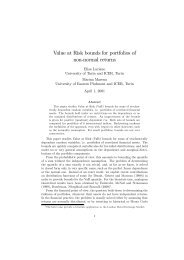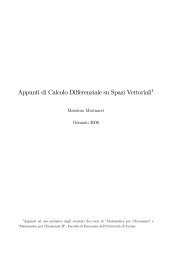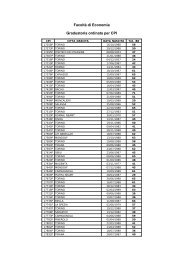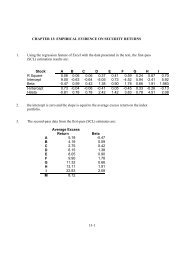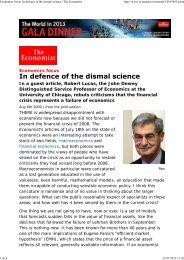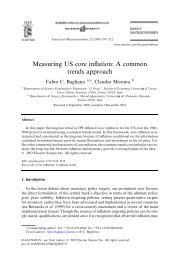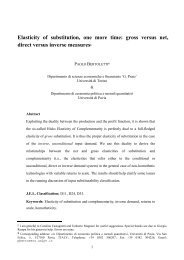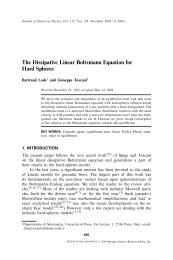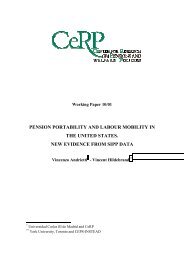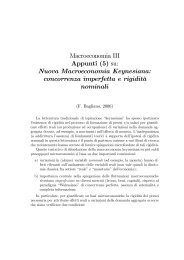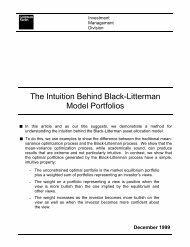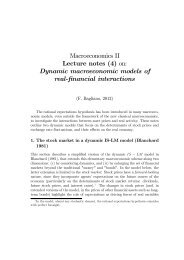Bivariate option pricing with copulas
Bivariate option pricing with copulas
Bivariate option pricing with copulas
You also want an ePaper? Increase the reach of your titles
YUMPU automatically turns print PDFs into web optimized ePapers that Google loves.
<strong>Bivariate</strong> <strong>option</strong> <strong>pricing</strong> <strong>with</strong> <strong>copulas</strong>U. CherubiniUniversity of Bolognaand ICER, TurinE. LucianoUniversity of Turin ∗First Version: May 10, 2000, this version: January 31, 2002.AbstractIn this paper we suggest the ad<strong>option</strong> of copula functions in order toprice bivariate contingent claims. Copulas enable us to imbed the marginaldistributions extracted from vertical spreads in the <strong>option</strong>s markets in amultivariate <strong>pricing</strong> kernel. We prove that such kernel is a copula function,and that its super-replication strategy is represented by the Fréchet bounds.As applications, we provide prices for binary digital <strong>option</strong>s, <strong>option</strong>s on theminimum and <strong>option</strong>s to exchange one asset for another. For each of theseproducts, we provide no-arbitrage <strong>pricing</strong> bounds, as well as the valuesconsistent <strong>with</strong> independence of the underlying assets. As a final referencevalue, we use a copula function calibrated on historical data.∗ The authors would like to thank an anonymous referee for useful comments that were ofgreat help for the revision of the paper. The usual disclaimer applies. Corresponding author:Elisa Luciano, Dept. Statistics and Applied Mathematics, P.zza Arbarello 8, I-10121 Torino,e-mail:luciano@econ.unito.it
1. IntroductionOne of the open issues in contingent claim <strong>pricing</strong> is how to extend, in full generality,the well-known risk-neutral valuation technique to the multivariate case,that is the case of contingent claims written on “baskets” of several underlyingassets, rather than on a single security.As the existing literature demonstrates, even the <strong>pricing</strong> problem of bivariatecontingent claims is far from elementary, whenever the simplifying — and sometimesunrealistic — hypothesis of independence or perfect correlation between theunderlying risks is abandoned. It becomes even more involved when another questionableassumption is dropped, that of joint normality of returns. In this paper wedescribe and implement some new results concerning bivariate contingent claims,whichholdinaverygeneralsetting.Options on the maximum, minimum or <strong>option</strong>s to exchange one asset foranother are “traditional” examples of bivariate claims. Recently, bivariate digital<strong>option</strong>s have come into fashion, particularly as building blocks, i.e. coupons,of structured debts products. More generally, one can also envisage a bivariatefeature in every OTC contract, due to the joint riskiness of the underlying andthe counterpart business (Klein, 1996).In this paper we abandon both the linear correlation and gaussian assumptionsin order to price bivariate claims. We explore copula functions as <strong>pricing</strong> devices.Copulas allow us not only to separate the impact on the joint distribution ofthe marginals and the association structure, but also to exploit non-parametricmeasures of the latter.The paper is structured as follows: section 2 presents the multivariate <strong>pricing</strong>problem in detail. Section 3 introduces the notion of copula, reviews some ofits properties and introduces the relationship <strong>with</strong> well-known non-parametricassociation measures. Section 4 explains how to use <strong>copulas</strong> to represent thebivariate digital <strong>option</strong> price, i.e. the <strong>pricing</strong> kernel of the bivariate economy.Section 5 extends the results to other bivariate claims, namely <strong>option</strong>s on theminimum and <strong>option</strong>s to exchange one asset for another. Section 6 presents anextensive application to four market indices (Mib30, S&P500, FTSE, DAX), forwhich we price bivariate digital <strong>option</strong>s, <strong>option</strong>s on the minimum and <strong>option</strong>s toexchange. Section 7 concludes.2
2. Multivariate Contingent ClaimsIn mathematical terms, the multivariate feature of a contingent claim shows upin a pay-off, which in general can be written asg(f(S i (T ),T; i =1, 2...n))where g(.) is a univariate pay-off function which identifies the derivative contract,f(.) is a multivariate function which describes how the n underlying securitiesdetermine the final cash-flow, S i denotes the price of the i−th underlying securityand T is the contract maturity. In what follows, for notational convenience, weskip the reference to T whenever it is not needed.As an example, in the case of rainbow call <strong>option</strong>s g is the familiar payofffunctiong(f) =max(f − K, 0)where K is the strike price, while f(·) may select the minimum (or maximum orsomekindofaverage)ofn assets:f(S i (T ),T; i =1, 2...n) =min(S i (T ); i =1, 2...n)The <strong>option</strong> on the minimum (or maximum) was first studied by Stulz (1982)in the lognormal case. In the same setting, Margrabe (1978) had already studiedthe most specific instance of the <strong>option</strong> to exchange.Another example, which is easier to address, is the multivariate digital <strong>option</strong>.In this case the g function is simply a multiplicative constant; f spots the eventthat each underlying be greater than or equal to some corresponding threshold K if(S i (T ),T; i =1, 2...n) =I {(S1 (T )≥K 1 )∩..∩(S n(T )≥K n)}where I is the indicator function.The multi-asset feature has a long standing history in fairly standard andmature derivative markets. The most standard case is offered by the market of<strong>option</strong>s on futures: as typically the standardization feature of futures contractsentails a delivery grade <strong>option</strong> (or quality <strong>option</strong>), the <strong>option</strong> on the futures contractmay be seen as an <strong>option</strong> written on a basket of deliverable products. Thequality <strong>option</strong> issue, however, has not posed much of a problem as for the <strong>pricing</strong>techniques: in fact, the standardization feature of futures contracts also impliesthat most of the products eligible for delivery were chosen in such a way as to3
grant a high degree of similarity. In other words, the products chosen as deliverableunder the contract are typically strongly correlated and considering themperfectlycorrelatedisnotmuchofamistake. Thisiswhatisdonewhenusingaone factor model of the term structure in order to evaluate the quality <strong>option</strong> onlong term interest futures and <strong>option</strong>s .It cannot be ignored that the perfect correlation assumption always leads toan approximation to the problem. Even in the case of the quality <strong>option</strong> ininterest rate futures we know that this approach is not able to take into accountsome market anomalies, such as coupon or seasoning effects, that may play arelevant role in the determination of the cheapest asset to deliver. Besides this,therearealsocasesinwhichtheimperfectcorrelationissuecannotbeavoided,as it represents the main motivation which inspires the product. In fact, the<strong>pricing</strong> task gets more involved for products in which the multiasset feature ismeant to provide diversification. The most straightforward example is offered bycall <strong>option</strong>s written on the minimum or maximum among some market indices.In these cases, ignoring imperfect dependence among the markets may lead tosubstantial mis<strong>pricing</strong> of the products, as well as to inaccurate hedging policiesand unreliable risk evaluations.While the multivariate — or simply bivariate — <strong>pricing</strong> problem may be alreadycomplex in a standard gaussian world, the evaluation task is compounded by thewell known evidence of departures from normality. Following the stock marketcrash in October 1987, departures from normality have shown up in the effects ofsmile and term structure of volatility and have become common ground of workfor both academics and traders.Of course, jointly taking into account non-normality of yields and their dependencestructure makes the two problems far more involved. As a simple exampleof this complexity, just consider the fact that the linear correlation figure cannotbe safely used in a non-normal world, as it may not be able to take values overthe whole range from -1 to +1 (see for instance Embrechts, McNeil and Straumann,1999a,1999b). In a non-gaussian world we may well observe a correlationfigure lower than 1 in a case in which there is perfect dependence between thevariables. So, the correlation figure may lead to mis-representation of the degreeof diversification in a portfolio. By the same token, in a non-gaussian world atrader may pursue the task of modifying the correlation figure of his portfolio toa value which is simply impossible to reach under the real bivariate distributionin the data.A possible strategy to address the problem of dependency under non-normality4
is to separate the two issues, i.e. working <strong>with</strong> non-gaussian marginal probabilitydistributions and using some techniques to combine these distributions in a bivariatesetting. This is the approach followed by Rosenberg (1999), who uses theset of Plackett distributions to price bivariate contingent claims consistently <strong>with</strong>given marginals. In the sequel we generalize his approach using copula functions,of which the Plackett family is only a specific case. The main advantage of thecopula approach to <strong>pricing</strong> is to write the bivariate <strong>pricing</strong> kernel as a function ofunivariate <strong>pricing</strong> functions. This enables us to carry out sensitivity analysis <strong>with</strong>respect to the dependence structure of the underlying assets, separately from thaton univariate prices.3. Mathematical backgroundIn what follows we give the definition of copula function and some of its basicproperties, while we refer the reader interested in a more detailed treatment toNelsen (1999) and Joe (1997). Since in the sequel we are going to price bivariateclaims, here we stick to the bivariate copula: nonetheless, most of the results carryover to the general multivariate setting.Definition 3.1. A two-dimensional copula C is a real function defined on I 2 d =[0, 1] × [0, 1], <strong>with</strong> range I d =[0, 1], suchthatfor every (v, z) of I 2 ,C(v,0) = 0 = C(0,z), C(v,1) = v, C(1,z)=z;for every rectangle [v 1 ,v 2 ] × [z 1 ,z 2 ] in I 2 ,<strong>with</strong> v 1 ≤ v 2 and z 1 ≤ z 2 , C(v 2 ,z 2 ) −C(v 2 ,z 1 ) − C(v 1 ,z 2 )+C(v 1 ,z 1 ) ≥ 0As such, it can represent the joint distribution function of two standard uniformrandom variables U 1 ,U 2 :C(u 1 ,u 2 )=Pr(U 1 ≤ u 1 ,U 2 ≤ u 2 )We can use this feature in order to re-write via <strong>copulas</strong> the joint distributionfunction of two (even non-uniform) random variables. The most interesting factabout <strong>copulas</strong> in this sense is Sklar’s theorem:Theorem 3.2 (Sklar (1959)). Let F (x, y) be a joint distribution function <strong>with</strong>continuous marginals F 1 (x) and F 2 (y). Then there exists a unique copula suchthatF (x, y) =C(F 1 (x),F 2 (y)) (3.1)5
Conversely, if C is a copula and F 1 (x), F 2 (y) are continuous univariate distributions,F (x, y) =C(F 1 (x),F 2 (y)) is a joint distribution function <strong>with</strong> marginalsF 1 (x), F 2 (y).The theorem suggests then to represent the multiplicity of joint distributionsconsistent <strong>with</strong> given marginals through <strong>copulas</strong>.Three specific <strong>copulas</strong> are worth mentioning: the product copula, the minimumand the maximum <strong>copulas</strong>. Families of <strong>copulas</strong> which encompass all of these<strong>copulas</strong> are called comprehensive. Asforthefirst, the copula representation of adistribution F degenerates into the so-called product copula, C(v, z) =v · z, ifand only if X and Y are independent. As for the others, they derive from thewell-known Fréchet-Hoeffding result in probability theory, stating that every jointdistribution function is constrained between the boundsmax(F 1 (x)+F 2 (y) − 1, 0) ≤ F (x, y) ≤ min(F 1 (x),F 2 (y)) (3.2)As a consequence of Sklar’s theorem, the Fréchet-Hoeffding bounds exist for <strong>copulas</strong>too:max(v + z − 1, 0) ≤ C(v, z) ≤ min(v, z)In correspondence of the extreme copula bounds, there is perfect positive andnegative dependence between the variables, and every variable can be obtained asa deterministic function of the other (see Embrechts, McNeil and Straumann,1999for a proof). Let us define the generalized inverse of a distribution function y =F 2 (x), asWe can state thatF −12 (y) =inf{t ∈ R : F 2 (t) ≥ y,0
In the first case, X and Y are called comonotonic, while in the second theyare deemed countermonotonic.Copulas are linked to non-parametric association measures by useful relationships.As an example, Kendall’s τ may be proved to beZ Zτ =4 C(v, z)dC(v, z) − 1I 2while Spearman’s ρ measure is given byZ Zρ =12 C(v, z)dvdz − 3 (3.3)I 2As a consequence of these results, it can be proved that the bounds of τ and ρare always -1 and +1. This is not true for the linear correlation coefficient, whosevalue depends on the specific shape of the marginal distribution functions, as canbe glanced from the relationshipZ Zcov(X, Y )= (F (x, y) − F 1 (x)F 2 (y)) dxdy (3.4)Dwhere D is the cartesian product of X and Y ’s domains.A particular class of <strong>copulas</strong>, the so-called Archimedean, is particularly easyto handle and will be used in this paper (see Genest and MacKay, 1986, Genestand Rivest, 1993).Archimedean <strong>copulas</strong> may be constructed using a generating function φ :[0, 1] → [0, ∞] continuous, strictly decreasing, convex and such that φ(1) = 0.Given such a function φ a copula may be generated computingC(v, z) =φ [−1] (φ(v)+φ(z)) (3.5)where φ [−1]is the pseudo-inverse of φ, defined as½φ [−1] φ −1 (u) 0 ≤ u ≤ φ(0)(u) =0 φ(0) ≤ u ≤∞Among Archimedean <strong>copulas</strong>, we are going to consider only the one-parameterones, which are constructed using a generator ϕ α (t), indexed by the parameter α.The table below describes well known Archimedean <strong>copulas</strong> and their generators(for an extensive list see Nelsen, 1999):7
Family φ α (t) range for α C(v,z)Gumbel (1960) (− ln t) α [1, +∞) expn− [(− ln v) α +(− ln z) α ] 1/αohi1Clayton (1978)α (t−α − 1) [−1, 0) ∪ (0, +∞) max (v −α + z −α − 1) −1/α , 0³´Frank (1979) −ln exp(−αt)−1 (−∞, 0) ∪ (0, +∞) − 1 exp(−α)−1 α ln 1+ (exp(−αv)−1)(exp(−αz)−1)exp(−α)−1Table 3: some Archimedean <strong>copulas</strong>The second and third are particularly interesting since they are comprehensiveaccording to the definition above. The Gumbel family gives the product copula ifα =1and the upper Fréchet bound min(v,z) for α → +∞: it describes positiveassociation only. The Clayton family gives the product copula if α → 0, thelowerFréchet bound max(v + z − 1, 0) when α = −1, andmin(v, z) for α → +∞. Toend up <strong>with</strong>, the Frank’s family, which is discussed at length in Genest (1987),reduces to the product copula if α → 0, and reaches the lower and upper Fréchetbounds for α →−∞and α → +∞, respectively.4. Pricing bivariate digital <strong>option</strong>sAs a first step to price bivariate contingent claims <strong>with</strong> <strong>copulas</strong> we may focus onthe case of bivariate digital <strong>option</strong>s. Every practitioner would agree that this caseis not simply of an academic interest, as this kind of derivative is present in somewidely known structured finance products such as bivariate digital notes, that isdebt instruments promising to pay a fixedcouponifthepricesoftwoassetsareabove some predefined strike levels at some future date and zero otherwise. Inorder to price and hedge products like these one has to find a replicating strategyfor the bivariate digital <strong>option</strong>. As there is not a market for them, this task wouldlead us straight into the problem of market incompleteness. One could even arguethat the problem is further complicated by the fact that replicating a digital notewritten on a single underlying asset would also be involved, as a market of digital<strong>option</strong>s is not available for each and every strike: while this is true, we may assumethat products like these may be satisfactorily approximated using vertical spreads,as suggested in the seminal work by Breeden and Litzenberger (1978) and in allthe more recent literature drawing from that idea (Shimko 1993, Rubinstein 1994,Derman and Kani 1994a,b to quote a few).8
In order to focus on the bivariate feature of the <strong>pricing</strong> problem, we assume thatwe may replicate and price two single digital <strong>option</strong>s <strong>with</strong> the same exercise dateT written on the underlying markets S 1 and S 2 for strikes K 1 and K 2 respectively.Our problem is then to use these products to replicate a bivariate <strong>option</strong> whichpays 1 if S 1 ≥ K 1 and S 2 ≥ K 2 and zero otherwise. Let us first break the samplespace, which coincides <strong>with</strong> the positive quadrant, in the four relevant regionsState HState LState H S 1 ≥ K 1 ,S 2 ≥ K 2 S 1 ≥ K 1 ,S 2
max(P 1 + P 2 − B,0) ≤ P (S 1 ≥ K 1 ,S 2 ≥ K 2 ) ≤ min(P 1 ,P 2 ) (4.1)Proof: assume first that the right side of the inequality is violated: say that,<strong>with</strong>out loss of generality, it is P (S 1 ≥ K 1 ,S 2 ≥ K 2 ) >P 1 ; in this case sellingthe bivariate digital <strong>option</strong> and buying the single digital <strong>option</strong> would allow afree lunch in the state [S 1 ≥ K 1 ,S 2 P(S 1 ≥ K 1 ,S 2 ≥ K 2 ); inthis case buying the bivariate digital <strong>option</strong> and a risk-free asset and selling thetwo single digital <strong>option</strong>s would allow a free lunch in the current date <strong>with</strong> nonnegativepay-off in the future (actually, the pay-off couldevenbepositiveifstate[S 1
• it is defined in I 2 =[0, 1] × [0, 1] and takes values in I =[0, 1];• for every v and z of I 2 ,C(v, 0) = 0 = C(0,z), C(v, 1) = v, C(1,z)=z;• for every rectangle [v 1 ,v 2 ] × [z 1 ,z 2 ] in I 2 ,<strong>with</strong> v 1 ≤ v 2 and z 1 ≤ z 2 ,C(v 2 ,z 2 ) − C(v 2 ,z 1 ) − C(v 1 ,z 2 )+C(v 1 ,z 1 ) ≥ 0Proof : The first condition is trivial: the prices of the digital <strong>option</strong>s cannot behigher than the risk-free asset B, implyingthantheforwardpricesofboththeunivariate and bivariate digital are bounded in the unit interval. As for the secondcondition, it follows directly from the no-arbitrage inequality (4.2), by substitutingthe values 0 and 1 for v = P 1 /B or z = P 2 /B. As for the last requirement, considertaking two different strike prices K 11 >K 12 for the first security, and K 21 >K 22for the second. Denote <strong>with</strong> v 1 theforwardpriceofthefirst digital correspondingto the strike K 11 ;<strong>with</strong>v 2 that of the first digital for the strike K 12 and use ananalogous notation for the second security. Then, the third condition above canbe re-written asP (S 1 ≥ K 12 ,S 2 ≥ K 22 ) − P (S 1 ≥ K 12 ,S 2 ≥ K 21 )+−P (S 1 ≥ K 11 ,S 2 ≥ K 22 )+P (S 1 ≥ K 11 ,S 2 ≥ K 21 ) ≥ 0As such, it implies that a spread position in bivariate <strong>option</strong>s paying one unit ifthe two underlying assets end in the region [K 12 ,K 11 ] × [K 22 ,K 21 ] cannot havenegative value 1 ¤.Matching the two propositions above <strong>with</strong> the mathematical definitions givenin the previous paragraph we may restate the main results of our analysis asProposition 4.3. The arbitrage-free <strong>pricing</strong> kernel of a bivariate contingent claimis a copula function taking the univariate <strong>pricing</strong> kernels as arguments P (S 1 ≥K 1 ,S 2 ≥ K 2 )/B = C(P 1 /B, P 2 /B), and the corresponding super-replicationstrategies are represented by the Fréchet bounds:µP1maxB + P µ2B − 1, 0 P1≤ CB , P µ2 P1≤ minBB , P 2B1 This property is akin to the requirement, in the one dimensional <strong>pricing</strong> problem, that the<strong>option</strong> price be decreasing and convex in the strike.11
It must be stressed that in order to prove the result we did not rely on anyassumption concerning the probabilistic nature of the arguments of the <strong>pricing</strong>function: these are only required to be no-arbitrage prices of single digital <strong>option</strong>s.In this respect, our results carry over to more general incomplete market<strong>pricing</strong> models that may use capacities, i.e. non-additive functionals, rather thanprobability measures, as <strong>pricing</strong> kernels. In the case in which the market is complete,so that these <strong>option</strong>s can be exactly replicated and the forward prices arethe risk-neutral probabilitiesP 1B =Pr(S 1 ≥ K 1 ) , P 2B =Pr(S 2 ≥ K 2 )we are allowed to give a straightforward probabilistic interpretation of our results,directly resorting to Sklar’s theorem. In a complete market, in fact, the bivariate<strong>pricing</strong> kernel is a bivariate probability measure and Sklar’s theorem ensures thatit could be written as a copula function taking the marginals as arguments. Wemay then writeP (S 1 ≥ K 1 ,S 2 ≥ K 2 )B=Pr(S 1 ≥ K 1 ,S 2 ≥ K 2 )=CµP1B , P 2B(4.3)The strength of these results is that they enable us to break the bivariate <strong>pricing</strong>kernel of the economy into a function of marginal univariate kernels: we may thenseparately extract marginal <strong>pricing</strong> kernels from vertical spreads and the bivariate<strong>pricing</strong> kernel of the economy from the dependence structure in the data.A finalwordisinordertoclarifythefinancial meaning the two no-arbitragebounds in (4.2), corresponding to the minimal and maximal copula functions.Looking over the result in theorem 3.3, these bounds associate our super-replicationstrategies to the cases of perfect negative and positive dependence between thetwo underlying assets. An interesting question is how wide the range between thetwo <strong>pricing</strong> bounds can be. It may be the case that assuming perfect dependenceleads us to overlook the most relevant feature of a bivariate contingent claim.In this case, relying on some figure representing the dependence structure in thedata may help to yield a more precise evaluation of the contingent claim. Indeed,knowing the dependence structure in the data may help to characterize the copulafunction used in order to price the bivariate contingent claim, as we are going toshow over the next sections.12
5. Pricing other bivariate claims5.1. Options on the minimum of two assetsWe turn now to the <strong>pricing</strong> of the <strong>option</strong> on the minimum between two riskyassets, which has been priced, in the Black-Scholes (lognormal) framework, byStulz (1982). We assume deterministic, non zero interest rates.The payoff of the call <strong>option</strong> on the minimum, <strong>with</strong> maturity T ,ismax(min(S 1 (T ),S 2 (T )) − K, 0)where K is the strike price. Provided only that interest rates are non-stochastic,its price at time t is·Z +∞¸B(T − t) qg(q)dq − K(1 − G(K))(5.1)Kwhere B(T − t) is the value at time t of the zero-coupon bond <strong>with</strong> maturity T ,g(q) is the risk-neutral density of the minimum, while G(K) is the correspondingdistribution function evaluated at K. In turn, since G can be computed to beG(q) =F S1 (q)+F S2 (q) − c(F S1 (q),F S2 (q))where c is the copula density, the density g(q) isg(q) =f S1 (q)+f S2 (q) − c 1 (F S1 (q),F S2 (q))f S1 (q) − c 2 (F S1 (q),F S2 (q))f S2 (q) (5.2)where c 1 and c 2 are the partial derivatives of c <strong>with</strong> respect to its arguments, whilef Si , i =1, 2, are the densities corresponding to F Si .5.2. Options to exchangeThe price of the <strong>option</strong> to exchange one asset for another, originally derived — forlognormal distributions — by Margrabe (1978), can be obtained as a portfolio ofone underlying and a zero-strike <strong>option</strong> on the minimum. In fact, the payoff ofthe exchange <strong>option</strong> ismax(S 1 (T ) − S 2 (T ), 0)which can be rewritten asS 1 − max(min(S 1 ,S 2 ), 0)13
Recalling that the risk-neutral expected value of the underlying at maturity is theforward price, it follows that its price is the current value of the first underlyingminus the price of the <strong>option</strong> on the minimum, <strong>with</strong> strike equal to zero. Usingthis device, under the assumption of deterministic, non zero interest rates, weobtain the exchange <strong>option</strong> value at time t asS 1 (t) − B(T − t)where the function g(q) is as defined above.6. Empirical applicationsZ +∞0qg(q)dq (5.3)In this section we apply <strong>copulas</strong> to the <strong>pricing</strong> problem of bivariate derivativeswritten on four indices: MIB30, S&P500, FTSE, DAX.We first derive the risk-neutral marginal density function of each index, usingthe technique proposed by Shimko (1993) 2 . We then obtain the lower and upperFréchet bounds for their joint distribution functions, which are the <strong>pricing</strong> kernelbounds. In order to pick out a single value between these bounds, one would needto observe at least one price of a bivariate claim. Since typically these products arenot traded on organized markets, we present a sensitivity analysis of the bivariate<strong>option</strong> values <strong>with</strong> respect to the dependence structure of the underlying assets.As a reference case, we choose a price consistent <strong>with</strong> the dependence statisticsestimated on historical data using a non parametric procedure 3 .6.1. Descriptive statistics and implied marginal densitiesThe data used for implied volatilities, time to maturity, dividend points and riskfreerate corresponding to the different markets were downloaded from Bloombergon March 27, 2000 and refer to European calls closing prices <strong>with</strong> June expirationand different strikes. As for the non-parametric dependence estimation, we usedthe time series of the corresponding indices, from January 2, 1999 to March 27,2000.2 The estimation technique for the marginals can be changed <strong>with</strong>out modifying the core ofour procedure.3 Sufficient conditions for the latter to be coincident <strong>with</strong> the no-arbitrage one, in spite ofhaving been estimated on historical data, are provided in Rosenberg (2000).14
We estimate the risk-neutral marginal distribution of each index (MIB30,S&P500, FTSE, DAX) on the cross section data of European calls. As a result,given a quadratic smile function σ(K) =A 0 + A 1 K + A 2 K 2 ,whereK is thestrike price, we recover the risk-neutral distribution function F S of the underlyingS:F S (s) =1+sn(D 2 (s)) √ T − t(A 1 +2A 2 s) − N(D 2 (s)) (6.1)S(t)lnB(T −t)sD 2 (s) =σ(s) √ T − t − 1 2 σ(s)√ T − twhere T − t is the time to maturity, n(·) and N(·) are respectively the densityand the distribution of the standard normal, S (t) is the current value of theunderlying, less the discounted dividends, and B(T − t) is the risk-free discountfactor for the same maturity of the <strong>option</strong>. Figure 6.1. reports the marginalrisk-neutral density functions obtained from the data.Insert here figure 6.1Using the four marginals so obtained, we numerically compute the lower andupper Fréchet bounds for the joint distributions. Substituting them in (3.3) werecover the correlation bounds in figure 6.2 below.Insert here figure 6.2The Fréchet bounds could be exploited for super-replication <strong>pricing</strong> of bivariateclaims. Before doing that, we present the results of copula estimation usinghistorical data, that will serve as a reference point for <strong>pricing</strong>: the copula estimationprocedure is described in Frees and Valdez (1998) and based on Genest andRivest (1993).In figure 6.3 we report the estimated parameters α for the families of Archimedean<strong>copulas</strong> described in table 3, as well as the standard non parametric statistics(Kendall’s τ and Spearman’s ρ).Insert here figure 6.3In what follows we will use Frank’s copula, both on the ground that it turnedout to provide a better fit in all cases - as measured visually and by the meansquare error - than the Clayton, and on the fact that the Gumbel copula does notallow for negative dependence.15
6.2. Option <strong>pricing</strong>Using the Frank’s copula and the estimation of the marginal densities describedabove we get the following joint distribution for each couple of indicesF (s 1 ,s 2 )=− 1 µα ln 1+ (exp (−αF S 1(s 1 )) − 1) (exp (−αF S2 (s 2 )) − 1)(6.2)exp (−α) − 1where F S1 (s 1 ),F S2 (s 2 ) are defined according to ( 6.1). This is the basic tool for<strong>option</strong> <strong>pricing</strong>, once the proper parameter estimates are plugged in. As an example,in figure 6.4. below we present the joint distribution (6.2) for the DAX/FTSEcase, together <strong>with</strong> the corresponding level curves 4 . The distribution was computedusing the historical estimate of α.6.2.1. <strong>Bivariate</strong> digital <strong>option</strong>Insert here figure 6.4First of all, using the joint distribution (5.2) we are able to price bivariate digital<strong>option</strong>s. In order to stress the immediate relationship between <strong>copulas</strong> andbivariate digital prices, we assume a zero interest rate and use proposition 4.3.above. In order to account for a deterministic, non-zero interest rate, it would besufficient to scale the prices presented below <strong>with</strong> the discount factor B(T − t).Figure 6.5. below presents some examples, again <strong>with</strong> α estimated from historicaldata, for the cases in which the corresponding single digital <strong>option</strong>s are outof-the-money(OTM), nearly at-the money (ATM) and in-the money (ITM). Thebivariate digital <strong>option</strong>s in the figure are then evaluated under different moneynesscombinations for each underlying. The maturity is that of the correspondingmarginals, i.e. three months.Incidentally, the reader can easily notice that the familiar behavior of prices<strong>with</strong> respect to moneyness is respected: prices are decreasing, for every couple of4 Level curves can be defined in terms of risk-neutral joint distributions or in terms of <strong>copulas</strong>.With respect to the latter they are defined as usual as© (v, z) ∈ I 2 | C(v, z) =t ªIn the Archimedean case they becomez = ϕ [−1] (ϕ(t) − ϕ(v))16
indices, from top left towards bottom right and, ceteris paribus, from left to rightand from top to bottom.Insert here figure 6.5By letting the strikes vary on a finer grid, we obtain the whole <strong>pricing</strong> surfacefor the three-month digital <strong>option</strong> on DAX and FTSE, which corresponds to therisk-neutral probability that both underlying assets be above the correspondingstrikes. In figure 6.6 below we present the <strong>pricing</strong> surface corresponding to thehistorically calibrated copula and to the product copula.Insert here figure 6.6In figure 6.7 we present a numerical example of the sensitivity analysis showngraphically above. The example refers to the case in which both of the strikes areeitherITMornearlyATM.Weanalyzehowthevalueofthe<strong>option</strong>changes<strong>with</strong>respect to the parameter α, as we move from perfect dependence to independenceof the underlying assets. By letting α reach its bounds the bivariate digital <strong>option</strong>prices converge to the Fréchet bounds, while the independence case (α =0)issimply the product copula.Insert here figure 6.76.2.2. Option on the minimum of two assetsIn order to implement formula (5.1), which gives the no-arbitrage price of the<strong>option</strong> on the minimum between two assets in the non-normal framework, oneneeds first the densities of the single underlying assets, f Si . For the cases describedin the previous sections, i.e. in the risk-neutral sense, and in particular given theexpression (6.1) for the marginal distribution functions, these densities turn outto behf Si (q) =n(D 2i (q)) D 2i (q) − (A 1i +2A 2i q) √ T − t(1 − D 2i (q)D 2i (q)) − 2A 2i q √ iT − t(6.3)where1D 2i (q) =−qσ i (q) √ T − t − D 1i(q)(A 1i +2A 2i q)σ i (q)D 1i (q) =D 2i (q)+σ i (q) √ T − t17
and the functions D 2i (q) and σ i (q) are defined as in section 5.1.Figure 6.8 presents the prices for ITM, ATM, OTM three-months call <strong>option</strong>son the minimum between DAX and FTSE, computed according to (5.1) and usingour estimate for the risk-neutral joint distribution function.Insert here figure 6.8In the first column we present the strike prices, corresponding to ITM (5653),ATM (6653) and OTM (7653) <strong>option</strong>s. Moneyness is defined<strong>with</strong>respecttotheFTSE index, whose current value on March 27, 2000, was 6653. From left toright, we present the prices corresponding to the historical association betweenthe two indices (α =4.469), to an hypothetical quasi perfect positive association(α =100), to independency (α = .0001) and to quasi perfect negative association(α = −100). The reader can easily notice that, ceteris paribus, <strong>option</strong> pricesare increasing <strong>with</strong> the association between the underlying assets, as the pricesget closer to the super-replication values. They are decreasing <strong>with</strong> the strike, asusual.6.2.3. Option to exchange one asset for anotherThelastlineofthetableinfigure 6.8 presents the price of the <strong>option</strong> to exchangeDAX for FTSE, corresponding to different α values. In order to understand the<strong>pricing</strong> technique used, let us recall from section 5 that the value at t of the <strong>option</strong>to exchange S 1 for S 2 at time T isS 1 (t) − B(T − t)Z +∞0qg(q)dqwhere g(q) is defined in (5.2) and is implemented knowing f Si (q),i=1, 2, reportedin the previous section.7. ConclusionsIn this paper we suggest a strategy to address the joint issues of non-normalityof returns and dependence in the bivariate contingent <strong>pricing</strong> problem. It is wellknown that under non-normality of returns the linear correlation is not an usefulindicator of dependence, as it may not cover the whole unit range. We suggest toresort to the concept of copula in order to account for this problem: using copula18
functions enables to “decouple” the <strong>pricing</strong> problem, addressing the specificationof marginal distributions and the dependence problem separately. A relevantadvantage of this approach is that it is directly amenable to concrete applications:as a matter of fact, we have very well developed markets for many products, andthe marginal distributions can be directly computed from the prices of verticalspreads of plain vanilla <strong>option</strong>s. The use of copula functions enables us to linkthese marginal distributions in a bivariate <strong>pricing</strong> kernel.As an example of the power of the approach, we present an application to fourstock market indices: for each market we use vertical spreads and the interpolationtechnique due to Shimko to recover the implied marginal probability distributionsfrom the market. We provide prices for bivariate digital <strong>option</strong>s, which representthe basis of prices for all of the bivariate contingent claims in the economy, as wellas for <strong>option</strong>s on the minimum and <strong>option</strong>s to exchange one asset for another. Foreach of these products, we provide super-replication prices, as well as the valuesconsistent <strong>with</strong> independence of the underlying assets. As a final reference value,we show how to price the bivariate <strong>option</strong>s using a copula function calibrated onhistorical data.19
Figure 7.1: Solid lines: risk-neutral densities of DAX (x), FTSE (y), S&P500 (z),MIB30 (u), computed according to (5.4). Dotted lines: corresponding lognormaldensities.Figure 7.2: Linear correlation bounds20
Figure 7.3: Estimated Kendall’s τ, Spearman’sR, andα for MIB30, S&P500,FTSE, DAX,1/2/99-3/27/00Figure 7.4: Joint distribution and level curves, DAX-FTSE21
Figure 7.5: Three-months binary digital <strong>option</strong> prices, selected strikes22
Figure 7.6: Binary digital <strong>option</strong> prices on DAX and FTSE, strikes 6300-10700,5300-9300, computed <strong>with</strong>: the historically calibrated copula and the product one(independence).Figure 7.7: Sensitivity analysis for the digital binary <strong>option</strong>, DAX-FTSE23
Figure 7.8: Prices of the call <strong>option</strong> on the minimum and <strong>option</strong> to exchange DAXfor FTSEReferences[1] Breeden, D.T. and Litzenberger, R.H., 1978, Prices of State-ContingentClaims Implicit in Option Prices, Journal of Business, 51, 621-51.[2] Derman, E. and Kani, I., 1994a, The volatility Smile and its Implied Tree,Quantitative Strategies Publication, Goldman-Sachs.[3] Derman, E. and Kani, I., 1994b, Riding on a smile, Risk, 7, 32-39.[4] Embrechts, P., McNeil, A. and Straumann, D., 1999a, Correlation and dependencein risk management: properties and pitfalls, ETHZ working paper.[5] Embrechts, P., McNeil, A. and Straumann, D., 1999b, Correlation: Pitfallsand Alternatives, Risk, 12, 69-71.[6] Fréchet, M., 1957, Les tableaux de corrélations dont les marges sont données,Annales de l’Université de Lyon, Sciences Mathématiques at Astronomie,SérieA,4,13-31.[7] Frees, E.,W. and Valdez, E., 1998, Understanding relationships using <strong>copulas</strong>,North American Actuarial Journal, 2,1-25.[8] Genest, C., 1987, Frank’s family of bivariate distributions, Biometrika, 74,549-555.[9] Genest, C. and MacKay, J., 1986, The joy of <strong>copulas</strong>: bivariate distributions<strong>with</strong> uniform marginals, The American Statistician, 40, 280-283.24
[10] Genest, C. and Rivest, L.P., 1993, Statistical inference procedures for bivariateArchimedian <strong>copulas</strong>, JournalofAmer.Statist.Assoc., 88, 423, 1034-1043.[11] Hoeffding, W., 1940, Massstabinvariante Korrelationstheorie, Schriften desMathematischen Seminars und des Instituts fur Angewandte Mathematik derUniversitat Berlin, 5, 181-233.[12] Joe, H., 1997, Multivariate models and dependence concepts, Chapman andHall, London.[13] Klein, P., 1996, Pricing Black-Scholes <strong>option</strong>s <strong>with</strong> correlated credit risk,Journal of Banking and Finance, 20, 1211-1230.[14] Margrabe, W., 1978, The value of an <strong>option</strong> to exchange one asset for another,Journal of Finance, 33, 177-186.[15] Nelsen, R.B., 1999, An introduction to <strong>copulas</strong>, Springer, New York.[16] Rosenberg, J.V., 1999, Semiparametric <strong>pricing</strong> of multivariate contingentclaims, NYU- Stern School of Business Working Paper.[17] Rosenberg, J.V., 2001, Non parametric <strong>pricing</strong> of multivariate contingentclaims, NYU- Stern School of Business Working Paper.[18] Rubinstein, M., 1994, Implied Binomial Trees, Journal of Finance, 49, 771-818.[19] Shimko, D.C., 1993, Bounds of probability, Risk, 6,33-37.[20] Sklar, A., 1959, Fonctions de repartition à n dimensions et leurs marges,Publication Inst. Statist. Univ. Paris 8, 229-231.[21] Stulz, R.M., 1982, Options on the minimum or the maximum of two riskyassets: Analysis and applications, Journal of Financial Economics, 10, 161-18525



